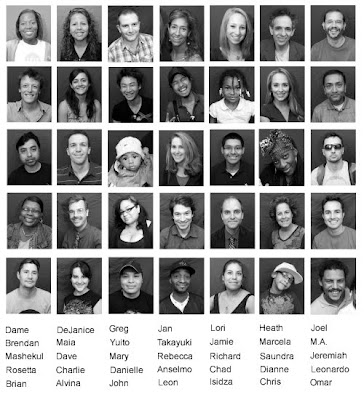Opening Ceremony. With much pomp and circumstance, photographers are formally introduced to the public. Special one-time only clothes are worn by participants as they make the obligatory circle through the gallery smiling, waving, and gladhanding, only to arrive afterward exactly where they started. The crowd ranges from high-ranking dignitaries to common gawkers. This is a powerful moment because at this point the future is unwritten and anything is possible! If the opening is successful, the artist's torch is lit and shines brightly for the next four years.
400 Meter Darkroom Door Hurdles. Photographers race around an oval track with revolving darkroom doors placed at 20 meter intervals. Contestants must run through the doors as quickly as possible without knocking them over.
 400 Meter Darkroom Door HurdlesSlow Synchronized Swimming
400 Meter Darkroom Door HurdlesSlow Synchronized Swimming. Photographers compete as eight-member teams. Team members swim choreographed routines of four-minute duration while carrying waterproof cameras and shooting slow-synch flash photos. Points awarded for creativity in choreography and photography, as well as synchronicity.
Biathlon. Photographers travel through a series of stations using cross-country skis and carrying an SLR mounted with 500 mm lens. At each station, photographers stop to shoot at a distant target. Points awarded for time and shooting accuracy.
 Photographer's BiathlonTechnology Jumping
Photographer's BiathlonTechnology Jumping. Photographers on skis attempt to jump as far as possible over a pile of obsolete gadgets from last year.
Weightlifting. Photographers place all their camera gear in a pile, including both working and broken equipment, then attempt to lift it above their heads. Unlike normal weightlifting, contestants are not allowed to throw down the weight after lifting. Gear must be set down gently, and points are deducted for dropping or damaging any equipment.
 Camera Gear WeightliftingFile Prep Medley Relay
Camera Gear WeightliftingFile Prep Medley Relay. Teams consisting of 4 members work to convert images as rapidly as possible from RAW format to exhibition print. The first team member converts RAW to properly sized and leveled working file, second member fine tunes spotting, noise, and sharpening, third member masters adjustments and color management, and fourth member makes print after print until a satisfactory exhibition proof is produced. Points awarded for time and final print quality.
Monopod Javelin Throw. Photographers throw a monopod mounted with continuously shooting camera as far as possible. Points awarded for distance and for best shot taken by the camera while airborne.
 Monopod Javelin ThrowPortfolio Review Gymnastics
Monopod Javelin ThrowPortfolio Review Gymnastics. Photographers compete in a series of floor exercises including jumping through various hoops, reaching for brass rings, and swinging on bars which are set progressively higher. Competition is judged by a panel of inscrutable and seemingly capricious officials.
Marathon. Contestants devote themselves to a shadowy, misunderstood, financially draining craft. They pursue it like an addiction day after day, year after year for the bulk of their adult lives. Points awarded for sheer endurance.



















































